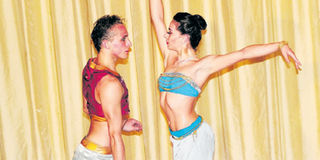Russian ballet returns on Dar stage in style

Russian dancers Aleksandra Balabanova and Daniil Blagov perform Adagio from “Scheherezada ballet by Nikolai Rimsky-Korsakov during a show at the Russian-Tanzania Culture Centre in Dar es Salaam. PHOTO | FILE
What you need to know:
DIGNITARIES FROM DIFFERENT EMBASSIES WITNESSED AS RUSSIAN DANCERS EXCITED THE CROWD WITH AN AMAZING PERFORMANCE IN DAR ES SALAAM
Dar es Salaam. After a short hiatus, Russian ballet is finally making its comeback to the Tanzanian stage - with what some observers have called an overwhelming force.
The weekends in Dar is always something longed for. After all, there must be a reason why the word “Saturday” (Jumamosi) means “first day of the week” in the Swahili language.
As night settled in on the ever-bustling city, the Russian-Tanzanian Culture Centre, aided by the Russian Embassy in Tanzania, opened its doors to everyone who came to enjoy a show put together by ballet dancers Aleksandra Balabanova and Daniil Blagov and singer Alexey Parfenov.
The Russian ballet first stormed the European stage in the opening decades of the 20th century courtesy of Sergei Diaghilev, an illustrious impresario who combined his passion for opera and dance with entrepreneurial acumen.
Most Russian art lovers at the time, even Diaghilev’s friends, dwelled on a skeptical keynote: what he was about to offer the sophisticated audiences in the West may have seemed too innovative at times.
The brave man, however, stood undaunted. And bingo! Les Ballets Russes premiered in Paris with astounding success.
Vaslav Nijinsky, Anna Pavlova, Michel Fokine, Tamara Karsavina, Serge Lifar, Olga Spessivtseva, Léonide Massine, Mathilde Kschessinska, Ida Rubinstein, Anton Dolin, George Balanchine - these are only some of the names that went down in international history of dance but also created a distinctive Russian style of ballet: grace, poise and almost supernatural technical perfection.
Moscow-based Balabanova and Blagov, formerly part of a ballet company, woke up one day to a decision to go independent.
While being your own Diaghilev might be a farfetched affair, the duo have a history of pulling off a motley of performances ranging from academic, classical ballet to edgy contemporary styles in Russia and beyond.
This time, they began with a dance from Giselle, one of the most beautiful romantic ballets of all time, followed by an enchanting oriental Adagio from Rimsky-Korsakov’s Sheherazade and a dance from Tchaikovsky’s Snow Maiden, culminating in Blagov’s dramatic solo in a khaki costume, as if to remind the audience of the many deadly wars raging in the world today.
To be able to use such a broad variety of musical vocabulary, the ballet dancers work out for up to 10 hours every day, most of it en pointe, with their feet exhausted and their dancing shoes soaked with blood.
While the much-touted ‘Black Swan’ film is an exaggeration in many ways, it does reflect some other less shiny aspects of ballet, such as cutthroat competition - and yes, the need to fit into your jeans.
Once you weigh a little over 50 kg, the dancing world will certainly turn its back on you. But neither of this stops hundreds of thousands of girls and boys vying for a vacancy in dancing academies across Russia every year.
The dream to emulate Pavlova on stage is greater than pain or fear.
Back to the night of November 26, singer Alexey Parfenov, who went off to a pretty serious operatic start, was soon dominating the scene with his witty interpretations of popular jazz pieces and Russian folk songs, to the joy of the audience that to a large extent consisted of young children.
But no less enthusiastic applause came from the ambassadors of Switzerland, Turkey and Italy, as well as representatives of the embassies of China, Japan, Norway and many other foreign missions.
Five years after their last appearance in Dar es Salaam, Russian performers have once again shown that one night is enough to make a difference in the cultural life of any city.
The author is a ballet enthusiast based in Dar es Salaam




